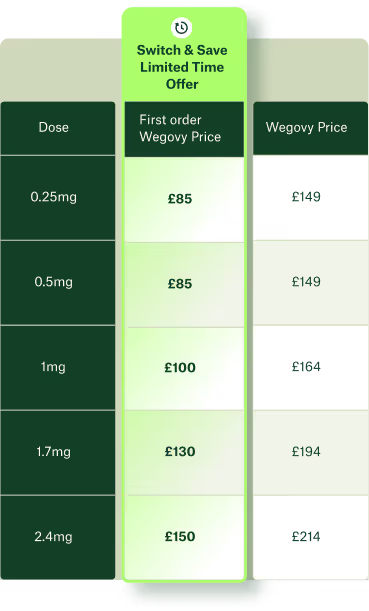GIP hormone: How it works for weight loss
Plus, what happens when it is used with GLP-1s.


Key takeaways
- Mounjaro (tirzepatide) is a dual GIP and GLP-1 receptor agonist, making it the first of its kind. It helps with weight loss by reducing appetite, slowing digestion, and improving glycemic control, leading to up to 20.9% body weight loss in clinical trials.
- While both Mounjaro and Wegovy are highly effective for weight loss, Wegovy mimics only GLP-1 and offers comparable results (up to 20.7% weight loss). Wegovy is more cost-effective, making it a favourable option for long-term weight management.
- With Mounjaro's UK price increase starting September 1, 2025, Juniper has reduced the cost of it's Wegovy programme by 25% and offers a seamless switch process, requiring only a 7-day gap between medications, along with tailored support to maintain progress.
The GIP hormone was originally discovered as a peptide that could inhibit gastric acid secretion and protect the small intestine from acid damage [1]. This explains its original name: gastric inhibitory polypeptide (or gastric inhibitory peptide).
Since then, it's been discovered that another hormone, secretin, is responsible for decreasing the production of stomach acid and that GIP actually plays a role in insulin secretion.
For this reason, researchers changed the name of the hormone to glucose-dependent insulinotropic polypeptide (or glucose-dependent insulinotropic peptide) but maintained its original acronym, GIP.
But what exactly is this hormone? Does it play a role in weight management and how is it different from GLP-1s? Let's find out.
What is the GIP hormone and what does it do in the body?
GIP is an incretin hormone released by K cells in your small intestine, which stimulates insulin secretion after you eat food.
It targets beta cells — which are unique cells found in the pancreas — in 2 ways:
- By encouraging them to secrete insulin, which helps keep your blood sugar levels low
- By increasing the cells' production and decreasing the rate at which they break down
When your pancreas and beta cells function properly, your body can convert insulin into glycogen, which is stored in your liver and muscle tissue, and then broken down into glucose when you need energy in between meals.
Additionally, GIP receptors are also found in:
- The brain, where the hormone promotes the production of cells that will eventually turn into nerve cells
- Bones, where it promotes bone formation and helps to prevent bone breakdown
Does GIP cause obesity?
For a long time, GIP was considered "the obesity hormone," with initial research suggesting that the hormone can, indeed, promote obesity. One study, in particular, found that excessive GIP secretion after nutrient consumption leads to increased body fat [2].
However, recent studies contradict this idea, with evidence that GIP receptor agonists can actually play a role in combating obesity — we'll explain how.
What happens when GIP and GLP-1s are used together?
GIP and GLP-1 — or glucagon-like peptide 1 — are both primary incretin hormones, which means they are both gut peptides released by the intestine after nutrient intake to aid digestion and stimulate insulin secretion.
However, these hormones aren't exactly the same. They have different benefits and work in different ways within the body.
Some research, for example, has found GLP-1s more potent than GIPs at managing type 2 diabetes [3]. GLP-1 stimulates insulin secretion, and so does GIP, but with the latter hormone, "the late phase response of insulin secretion is completely lost".
But the real question is, what happens when you combine GIP and GLP-1s? Well, you get an effective solution for overweight and obesity called tirzepatide [4].
This dual GIP and GLP-1 receptor agonist is more commonly known by its brand name Mounjaro and it has recently garnered a lot of attention. This attention is well-deserved not only because tirzepatide is the first of its kind but because, according to clinical trials, it is one of the most effective weight loss drugs currently available.
How it works is it mimics both GIP and GLP-1 receptor agonists. By doing so, it alerts the pancreas to stop releasing insulin after you eat and decreases glucagon secretion, which slows down digestion and helps you feel fuller for longer — and all of this can help with weight loss and management.
This GIP/GLP-1 combination is also effective in helping patients with type 2 diabetes improve glycemic control and lose weight [5].
GIP/GLP-1 vs GLP-1
While Mounjaro contains a combination of GIP and GLP-1, another weight loss medication, Wegovy, mimics just GLP-1. Although similarly to Mounjaro, Wegovy also helps to reduce appetite, dull cravings and delay stomach emptying, to keep you feeling fuller for longer and, in turn, lead to weight reduction.
In clinical trials, patients on the highest possible dose of Wegovy lost up to 20.7% of their body weight [6], compared to 20.9% with Mounjaro at its highest dose [7] — showing that both can be highly effective when used consistently and with the right support. This higher dose of Wegovy isn’t available just yet, but it’s expected to launch in the UK soon.
However, Wegovy is often a more cost-effective option compared to Mounjaro, making it more favourable for ongoing weight management.
Can you switch from Mounjaro to Wegovy?
From 1 September 2025, Eli Lilly, the manufacturer of Mounjaro (tirzepatide), will increase its UK list price to align with other developed countries. This nationwide change applies to providers including pharmacies, private clinics, and digital platforms.
In response, we’ve lowered the price of our Wegovy programme by 25%, and we’re making it easier for patients to switch without starting over, so that effective treatment remains within reach for as many people as possible.
So, if you've been wondering if you can switch from Mounjaro to Wegovy, the good news is that it's both safe and straightforward.
When making the switch, Juniper patients don’t need to restart at the lowest dose. If clinically appropriate, they can continue at a higher dose aligned with recent treatment history. We also only require a 7-day gap between your last Mounjaro dose and your first Wegovy dose — unlike most providers, who require 28 days.
At Juniper, we make that switch seamless and fully supported — so you can protect your progress without paying more than you need to. Our clinical switching protocol is is simple and safe:
- Review — Your clinician assesses your treatment history and dose tolerance.
- Match — If eligible, you start on an equivalent high dose to avoid losing progress.
- Transition — Only a 7-day window is required between your last Mounjaro dose and your first Wegovy dose (most providers require 28 days).
- Support — Pharmacist check-ins, dose adjustments, and lifestyle guidance keep you on track.
Start your Wegovy switch today →

Are there any side effects to using GIP and GLP-1s together?
All medications come with potential side effects and tirzepatide, or Mounjaro, is no different. The most common side effects include nausea, vomiting, diarrhoea, decreased appetite, pain in the abdominal area, and constipation.
However, these typically happen when you first start taking the drug (or increase your dosage) and should subside as your body gets used to it.
Can you access Mounjaro in the UK?
Mounjaro is available in the UK, including as part of the Juniper Programme. Based on your eligibility requirements and personal preferences, your Juniper clinician will prescribe you either Wegovy or Mounjaro, in conjunction with prescriber-support, health tracking tools and access to our Juniper community.
By taking the Juniper quiz, you can check your eligibility and kickstart, or restart, your journey towards a healthier and happier you. Juniper offers tailored treatment plans based on your needs, taking your experience with medication and goals into account.
We’re in it with you for the long run; having helped thousands of Juniper patients. Once in the programme, you’ll have regular access to a team of health professionals who are here to listen, guide and help unlock a healthier you.
Image credit: Getty Images

in 1 year
- Clinically-backed weight loss treatments
- Personalised nutrition and exercise plan
- Trusted by 30,000 members around the world

- https://www.ncbi.nlm.nih.gov/pmc/articles/PMC4854497/
- https://pubmed.ncbi.nlm.nih.gov/34176784/
- https://www.metabolismjournal.com/article/S0026-0495%2819%2930086-1/fulltext
- https://www.sciencedirect.com/science/article/pii/S1043276020300485
- https://pubmed.ncbi.nlm.nih.gov/35929488/
- https://www.novonordisk.com/content/nncorp/global/en/news-and-media/news-and-ir-materials/news-details.html?id=915087
- https://www.nejm.org/doi/full/10.1056/NEJMoa2206038











